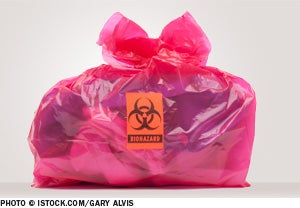Trade groups seek clarification on linen handling

A misinterpretation of regulations on handling of blood-saturated linen is creating unnecessary costs for hospitals when they mistakenly have it hauled away as regulated waste and again when they replace the materials.
To resolve the problem, the Association for Linen Management (ALM) and the American Reusable Textile Association (ARTA) have teamed up to ask the Occupational Safety & Health Administration (OSHA) for clarification on regulations for proper handling of blood-saturated linen.
Health care laundry operators estimate that as much as 25 percent of linen that is saturated with blood or bodily waste is disposed of incorrectly as regulated waste in red bags, according to ARTA. In addition, ARTA recently surveyed 200 nurses and other staff at five health care systems throughout the United States and learned that 95 percent of them had disposed of at least one linen item as red bag waste. The cost for hauling away red bag waste ranges from 18 to 33 cents per pound, ARTA states.
The problem appears to be a misinterpretation by hospital risk managers of the OSHA definition for regulated waste. "I can see how the error in interpretation may have occurred, but reusable linen is not waste," says Linda Fairbanks, executive director, ALM. In fact, blood-saturated linen is highly cleanable and reusable, she says.
OSHA defines regulated waste in part as "contaminated items that would release blood or other potentially infectious materials in a liquid or semiliquid state if compressed." But OSHA also says that laundry contaminated with blood or other potentially infectious materials can be placed in a bag that will adequately contain the soiled linens.
"We believe, and OSHA has confirmed, that it was never the intent that reusable linen was to be thrown away," Fairbanks says. ALM and ARTA have requested a written letter of interpretation from OSHA that will provide hospitals with explicit guidance that blood-saturated linen should not be disposed as regulated waste.
[In late October, an OSHA letter of interpretation was sent to ALM and ARTA that affirmed the proper protocols for handling contaminated linen and specified that bags used to collect contaminated linen must be correctly labeled. The letter can be accessed on each group's Website.]


